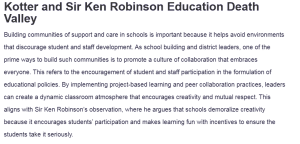Kotter and Sir Ken Robinson Education Death Valley
Building communities of support and care in schools is important because it helps avoid environments that discourage student and staff development. As school building and district leaders, one of the prime ways to build such communities is to promote a culture of collaboration that embraces everyone. This refers to the encouragement of student and staff participation in the formulation of educational policies. By implementing project-based learning and peer collaboration practices, leaders can create a dynamic classroom atmosphere that encourages creativity and mutual respect. This aligns with Sir Ken Robinson’s observation, where he argues that schools demoralize creativity because it encourages students’ participation and makes learning fun with incentives to ensure the students take it seriously.
Other than promoting the development of a collaborative group of students, there is a crucial need for the professional development of educators for the development of supportive communities. Topics during the training should address social-emotional well-being and culturally responsive training so that teachers can identify students’ needs. Educators who receive supervision that addresses their professional learning needs are more likely to develop learning environments that meet their learners’ social and academic emotional support needs (Robinson, 2013). When creating staff that conduct teaching in their schools, leaders improve teaching admiringly and make students feel abreast to see teachers well equipped to handle them.
To create these communities of care, it is imperative to consider lifelong social-emotional learning, or, in this case, mental health and wellness, in the context of the school. Culturally, school leaders should now start engaging in strategies to boost mental health by guaranteeing safety and access to counseling and wellness. When students and staff are assured they can seek help, they become responsible and able to support each other in case of hardships. Further, support for teachers who need to care for themselves and provide mental health services also decreases burnout, which is even worse in a class. Mental health is a valued value in the school, therefore ensuring that leaders promote other aspects of the well-being of students apart from academics to ensure that the philosophy of education is complete.
Finally, school leaders must extend the sense of community beyond the classroom by fostering partnerships with families and local organizations. Engaging parents and community members in school activities helps to reinforce the idea that education is a shared responsibility. Events that unite families, educators, and community stakeholders create a student support network, enhancing their educational experience and well-being. Sir Ken Robinson emphasizes the need for educational institutions to break down silos and become more integrated within their communities. By doing so, school leaders can cultivate environments where students and staff feel connected and supported, ultimately leading to a more vibrant and effective educational experience.
References
Robinson, K. (2013, April). How to escape education’s death valley [Video]. TED Talks. https://www.ted.com/talks/sir_ken_robinson_how_to_escape_education_s_death_valley?subtitle=en
ORDER A PLAGIARISM-FREE PAPER HERE
We’ll write everything from scratch
Question 
Using Kotter and Sir Ken Robinson’s “Education’s Death Valley”
- VIDEO: https://www.ted.com/talks/sir_
ken_robinson_how_to_escape_ education_s_death_valley? subtitle=en

Kotter and Sir Ken Robinson Education Death Valley
Write a 1 ½ page reflection submission answering the following question:
- How do we (as school building and school district leaders create communities of care and support in classrooms with students, school buildings and school districts with teachers and school staff members?